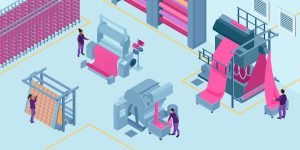A garment factory is a key component in the fashion industry that transforms raw materials, such as fabric, into ready-to-wear clothing products. In this article, we’ll explore how garment factories work, the production stages involved, and the role of automation technology in improving efficiency and quality.
What Is a Garment Factory?
Simply put, a garment factory is a facility that produces various types of clothing, from t-shirts and shirts to trousers and jackets. The success of a garment factory depends on the integration between workforce skills and technological support to maintain quality standards.
Work Processes in Garment Factories
- Design and Product Planning
Production begins with the design phase, where creative teams create patterns and models according to market trends and consumer needs. These patterns become references for subsequent production stages.
- Fabric Receipt and Inspection
After receiving raw materials in the form of fabric, the next step is quality inspection. Only fabric meeting standards will be used for production, ensuring high-quality end results.
- Fabric Relaxation
The fabric relaxation process is done to remove excess tension and moisture that may occur during storage or transportation. This stage is crucial to prevent wrinkles and shrinkage during production.
- Fabric Cutting
Inspected and relaxed fabric is cut according to patterns using automated cutting machines or manually, depending on production scale and type. Cutting accuracy greatly determines efficiency and minimizes material waste.
- Sewing Cut
fabric pieces are then sewn together to form the final product. Sewing is a crucial stage as it involves neatly joining product parts. Automated sewing machines are increasingly used to maintain consistency and production speed.
- Quality Control and Finishing
After sewing, each product undergoes quality control to ensure there are no defects. Finishing processes, such as ironing, folding, or final inspection are performed to prepare market-ready products.
- Packaging and Distribution
Products that have passed quality control are properly packaged before distribution to customers or retail markets. Proper packaging also plays a role in maintaining product quality during shipping.
Challenges in the Garment Factory Industry
A garment factory is a sector facing several challenges, including:
- Rapid fashion trend changes, requiring factories to always be ready for design and production adjustments.
- Demands for sustainable production by reducing waste and energy consumption.
- Intense global competition, requiring factories to improve efficiency and maintain product quality consistency.
- Labor welfare issues that need attention to maintain supportive working conditions for productivity.
The Role of Automation Technology in Garment Factories
In addressing these challenges, automation technology plays a vital role: • Production Process Optimization By utilizing automated machines, such as automated cutting and sewing machines, garment factories can increase productivity while reducing human error. • Real-Time Monitoring Data-based monitoring systems allow factories to track machine performance and production processes in real-time, facilitating strategic decision-making. • Waste and Energy Consumption Reduction Automation helps minimize production errors, reducing raw material waste and supporting energy efficiency. • Consistent Product Quality Precise automated machines ensure each product meets uniform quality standards, increasing consumer confidence in overall products.
Case Study: The Role of Automation Solution Providers
As an example of automation technology implementation, companies like PUKKA INDONUSA provide solutions to support garment factories in improving production efficiency. PUKKA INDONUSA isn’t directly involved in clothing production but provides technology and automation systems that enable:
- Optimization of workflow in garment factories.
- Direct supervision through real-time data systems.
- Quality improvement through tighter process control.
- Support for reducing environmental impact through waste reduction.
Conclusion
A garment factory is a key component in the fashion industry that significantly contributes to the economy. By understanding the processes and challenges faced, we can see the important role of technology and automation in improving efficiency and product quality. Automation solution providers, like PUKKA INDONUSA, support digital transformation in this sector, enabling the garment industry to continue developing while meeting innovation and sustainability demands.



Would you like to share your thoughts?